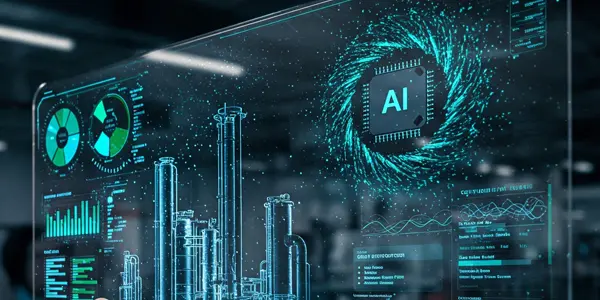
Cost estimating has always been a critical function in the process industry, influencing budgeting, project feasibility, and financial decision-making. Traditionally, estimators relied on manual calculations, historical data, and expert judgment to forecast costs. However, with advancements in computer technology and artificial intelligence (AI), the cost estimating process is going through a significant transformation. This blog explores how cost estimating is evolving, the (potential) role of AI in modern estimating, and some key benefits and challenges of AI-driven cost estimation.
How traditional cost estimating processes are evolving
Historically, cost estimation in the process industry has been a time-consuming task that depended heavily on spreadsheets, experience-based assumptions, and static cost databases. The process typically involved:
- Gathering current and historical cost data
- Setting up project structures and collecting project scope
- Estimating costs, based on limited design data and incomplete project information
- Applying factors, rates, and inflation corrections
- Reporting the estimate to stakeholders
- Maintaining historical cost data and estimates
The above often takes a lot of time, up to months, and often needs to be done within limited time. Historical data and estimates are mostly stored on personal computers or simply printed and lost. Especially inexperienced estimators or organizations fail at delivering accurate estimates on time.
The rise of cost estimating software
With the advent of computer technology, cost estimating software solutions became widely used to improve accuracy and efficiency. These tools provided standardized cost databases, automated calculations, and parametric models that allowed estimators to analyze costs with greater precision. However, most software still requires extensive manual effort and estimating knowledge and is limited by the quality and availability of historical data.
The introduction of AI for cost estimating processes
Today, AI-driven solutions are revolutionizing the estimating process by introducing automation, real-time data analysis, and predictive modeling, reducing manual efforts and improving estimate reliability.
AI methods for cost estimating
AI enhances cost estimation by utilizing machine learning algorithms, natural language processing (NLP), and predictive analytics. Here’s how AI is making an impact:
- Automated data analysis: AI can process vast amounts of structured and unstructured data from historical projects, supplier databases, and market trends to generate more accurate cost estimates.
- Predictive cost modeling: Machine learning algorithms identify cost patterns and correlations, improving the accuracy of forecasts by learning from past estimating errors.
- Dynamic cost updates: AI integrates real-time data from sources such as commodity prices, labor rates, and supply chain disruptions to ensure estimates reflect current market conditions.
- AI-powered parametric estimating: AI enhances traditional parametric models by continuously refining cost relationships based on new project data.
- Automated risk analysis: AI can assess uncertainty and risk factors in estimates, providing probability-based cost ranges rather than a single deterministic value.
- Natural language processing (NLP) for cost extraction: AI can extract cost-relevant data from project specifications, contracts, and supplier documents, reducing manual data entry.
Key benefits of using AI for Cost Estimation

Integrating AI into the cost estimating process offers several advantages over traditional methods:
- Greater accuracy: AI reduces human error by leveraging real-time data and continuously improving its predictions.
- Faster estimates: AI automates repetitive tasks, significantly reducing the time required to generate detailed cost estimates.
- Improved consistency: AI ensures that estimates follow standardized methodologies, reducing variability in cost projections.
- Enhanced decision-making: With AI-powered insights, project managers and stakeholders can make better-informed financial and strategic decisions.
- Proactive cost optimization: AI helps identify cost-saving opportunities by analyzing patterns and recommending alternative materials, processes, or suppliers.
- Scalability: AI enables companies to handle larger volumes of cost estimates without increasing human resource requirements.
Challenges and considerations
Despite its advantages, AI adoption in cost estimating comes with challenges:
- Data quality and availability: AI models require high-quality, structured data to function effectively. Incomplete or inaccurate historical cost data can impact AI predictions.
- Initial implementation costs: Developing or adopting AI-powered estimating systems can require significant investment in technology, training, and integration.
- Human oversight still required: AI can enhance estimating but cannot fully replace human judgment, especially for complex, unique, or first-of-a-kind projects. For a deeper dive into this topic, check out our blog on “Will AI Replace Project Managers?“.
- Bias and model limitations: If AI is trained on biased or outdated data, it may produce inaccurate estimates. Continuous model validation and updates are necessary.
- Cybersecurity and data privacy: AI systems rely on large datasets, raising concerns about data security, proprietary information, and compliance with regulations.
Conclusion
The evolution of cost estimating in the process industry has been significantly influenced by advancements in computer technology and AI. While traditional estimating relied on manual calculations and expert judgment, AI can enable automated data processing, predictive analytics, and real-time cost modeling. The benefits of AI in estimating, such as improved accuracy, speed, and consistency, make it an invaluable tool for modern project management. However, companies must address challenges related to data quality, implementation costs, and AI limitations to maximize its potential.
As AI technology continues to evolve, its role in cost estimating will only expand, paving the way for smarter, more efficient, and data-driven decision-making in the process industry.
Project management software vs Excel, which one suits your needs? Excel has long been a go-to tool for…
As a cost engineer looking for a cost estimating software tool to create and manage estimates, one of your most…
Related resources

Will AI Replace Project Managers?
According to Gartner, Artificial Intelligence (AI) will take over 80% of project management tasks by 2030. That is just a little more than 5 years from today. This bold claim raises a pressing question: Will AI replace project managers?
Read blog article
AI In Industrial Processing: Applications And Challenges
Explore AI in industrial processing, its potential applications, and challenges for professionals in project and turnaround management.
Read blog article